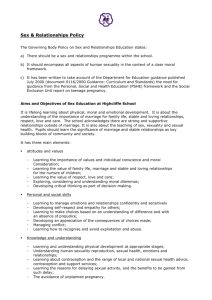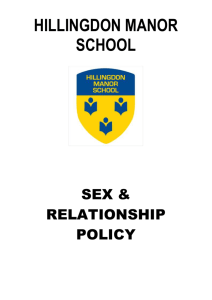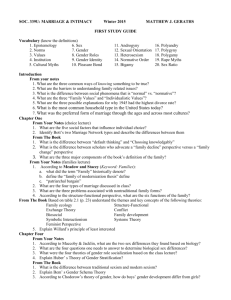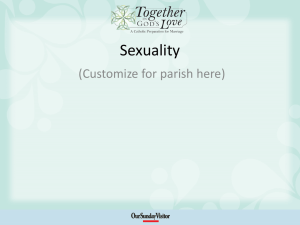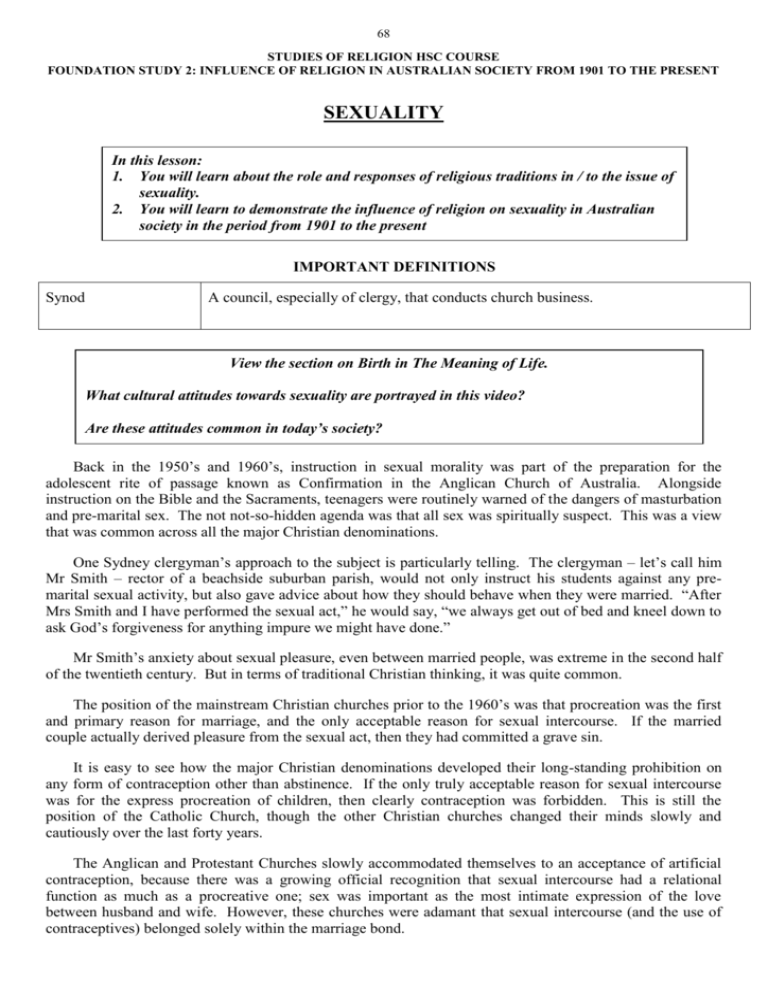
68
STUDIES OF RELIGION HSC COURSE
FOUNDATION STUDY 2: INFLUENCE OF RELIGION IN AUSTRALIAN SOCIETY FROM 1901 TO THE PRESENT
SEXUALITY
In this lesson:
1. You will learn about the role and responses of religious traditions in / to the issue of
sexuality.
2. You will learn to demonstrate the influence of religion on sexuality in Australian
society in the period from 1901 to the present
IMPORTANT DEFINITIONS
Synod
A council, especially of clergy, that conducts church business.
View the section on Birth in The Meaning of Life.
What cultural attitudes towards sexuality are portrayed in this video?
Are these attitudes common in today’s society?
Back in the 1950’s and 1960’s, instruction in sexual morality was part of the preparation for the
adolescent rite of passage known as Confirmation in the Anglican Church of Australia. Alongside
instruction on the Bible and the Sacraments, teenagers were routinely warned of the dangers of masturbation
and pre-marital sex. The not not-so-hidden agenda was that all sex was spiritually suspect. This was a view
that was common across all the major Christian denominations.
One Sydney clergyman’s approach to the subject is particularly telling. The clergyman – let’s call him
Mr Smith – rector of a beachside suburban parish, would not only instruct his students against any premarital sexual activity, but also gave advice about how they should behave when they were married. “After
Mrs Smith and I have performed the sexual act,” he would say, “we always get out of bed and kneel down to
ask God’s forgiveness for anything impure we might have done.”
Mr Smith’s anxiety about sexual pleasure, even between married people, was extreme in the second half
of the twentieth century. But in terms of traditional Christian thinking, it was quite common.
The position of the mainstream Christian churches prior to the 1960’s was that procreation was the first
and primary reason for marriage, and the only acceptable reason for sexual intercourse. If the married
couple actually derived pleasure from the sexual act, then they had committed a grave sin.
It is easy to see how the major Christian denominations developed their long-standing prohibition on
any form of contraception other than abstinence. If the only truly acceptable reason for sexual intercourse
was for the express procreation of children, then clearly contraception was forbidden. This is still the
position of the Catholic Church, though the other Christian churches changed their minds slowly and
cautiously over the last forty years.
The Anglican and Protestant Churches slowly accommodated themselves to an acceptance of artificial
contraception, because there was a growing official recognition that sexual intercourse had a relational
function as much as a procreative one; sex was important as the most intimate expression of the love
between husband and wife. However, these churches were adamant that sexual intercourse (and the use of
contraceptives) belonged solely within the marriage bond.
69
The ‘no sex outside marriage’ rule (also supported by the Catholic Church, Judaism and Islam)
continued to hold fast, and still does officially, although most denominations now recognise that
contraception is the responsible option for relationships outside marriage.
The pill became available in Australia in 1961. The sexual revolution had arrived, and relationships
between men and women had changed forever. The lives of women had been turned upside down. Now for
the first time in history they could control their fertility without sacrificing sexual relationships, and could
plan whole-of-life careers instead of occasional jobs.
The Anglican and Protestant churches accepted that family planning was now not just possible but
actually desirable within marriage, but their position on sex outside marriage did not change. The Catholic
Church maintained its prohibition on all forms of artificial contraception. At the same time, however, the
Church emphasised that contraception for Catholics was a conscience matter.
The advent of reliable and acceptable contraception has completely changed the sexual landscape in
Australian society. It has turned sex into a publicly-acknowledged leisure pursuit, the subject of endless
magazine articles, television programs and films. In this environment, the notion that homosexual people
should be denied all sexual expression, has become unacceptable to the wider Australian community. Both
the Anglican and Uniting Churches have prepared major reports on the subject. The Catholic Church has
chosen to remain silent on the issue but shows its stance by refusing Holy Communion to church members
who publicly identify themselves as homosexuals. The Catholic Church condemns sexual relations between
homosexuals because they are not explicitly open to procreation. Islam takes an equally strong stance,
regarding homosexuality to be against the laws of nature and sexual intercourse between two homosexuals
as depriving them of decency, morality and dignity. Whilst, in Jewish thinking, a man feeling attracted to
another man is no different from him being attracted to someone else’s wife, allowing this attraction to lead
to a sexual relationship is a sin.
Homosexuality is one of the key issues facing religious traditions in Australia at the beginning of the
twenty first century. The emergence of the Gay and Lesbian Mardi Gras as a major event in the festive
calendar of Sydney life has challenged the values and morality of religious organisations. The Catholic and
Anglican Churches had chosen not to present their views on the Mardi Gras in any outspoken way until
February 2000. The Sydney archbishops of both churches, perhaps fearing that their silence may read as
assent, suggested that government and people’s support for the Mardi Gras promoted homosexual lifestyle,
contrary to the churches’ promotion of family and fidelity.
In 1998, a total of 140 Uniting Church members, including seventeen ministers, participated in the
Mardi Gras. Their float was not a formal entry by the Uniting Church, and the group was requested by the
National Assembly and New South Wales Synod not to march with the Uniting Church logo. The group’s
banner read, “Celebrating diversity, members of the Uniting Church”. Other Uniting Church members took
out large advertisements featuring the Uniting Church logo in the Sydney papers, stating that, while the
Uniting Church affirms the value of every person in God’s eyes it was with regret that they disagreed with
those who participated as Uniting Church persons in the Mardi Gras. “We see this event as a festival which
demeans sexuality and which encourages and celebrates promiscuous behaviour at great cost to our city and
nation.”
In the 2000 parade, many Jews marched together for the first time, many of the group carrying pink
placards in the shape of the stars of David. This action caused division among the Jewish community.
Clearly, the issue is a complex one, which has drawn a full range of responses from people who profess
the very same religious basis for their views. This is not uncommon, and can often be seen in response to
controversial aspects of modern Australian life. The diversity of views that arise out of a common religious
basis is evidence of the dynamic relationship that exists when culture and religion interacts.
Some argue that the Christian churches’ condemnation of the human sex drive and sexual experience
outside marriage, is responsible for the recent break out of sex in Australian society. The ‘anything goes’
70
mentality, the obsession with sex themes in modern entertainment and culture are a backlash from centuries
of unhealthy suppression and anti-women attitudes. On the other hand, it can be argued that the drop in
moral standards so evident in Australian society since the 1960s can be attributed to a profound cultural
shift, driven by science and technology, which is marked by –
The demotion of religion to the sphere of the private and personal.
A strong focus on the importance and rights of the individual at the expense of the common good.
Whatever the cause, truly healthy cultural attitudes to sexuality need to be created, and the Christian
churches and the other religious traditions present in Australian society should be leaders in that process.
Perhaps this will mean the abandonment of some rules, but for true progress to be realised , there also has to
be some overriding absolute principles.
Do you think the Churches are responsible for the sexual revolution that has taken place
since the 1960s?
Use an opinion continuum to discuss this question.
References
Apostolic Constitution. (1992). Catechism of the Catholic Church. Homebush: Saint Pauls.
Board of Studies. (1999). Stage 6 syllabus: studies of religion. Sydney: Board of Studies New South
Wales.
Chapman, G., Cleese, J., Gilliam, T., Idle, E., Jones, T., & Palin, M. (1983). The meaning of life. In T.
Jones (Ed.): Universal Pictures.
Collins, P. (1995). God's earth: religion as if matter really mattered. Blackburn: Dove.
Forta, A. (1991). Judaism. In W. Cole, Owen (Ed.), Moral issues in six religions (pp. 150-185).
Melbourne: Heinemann Educational Publishers.
Kendrick, R. (1991). Islam. In W. Cole, Owen (Ed.), Moral issues in six religions (pp. 114-149).
Melbourne: Heinemann Educational Publishers.
Morrissey, J., Mudge, P., Taylor, A., Bailey, G., Gregor, H., McGillion, C., O'Reilly, P., Magee, P., &
Mills, L. (2001). Living religion (2nd ed.). Sydney: Longman.
Porter, M. (2001). Sex and marriage: the Christian tradition. In C. Wood (Ed.), Sexual positions: an
Australian view (pp. 46-59). Melbourne: Hill of Content Publishing.
©
Emmaus Publications (2002). Every effort has been made to trace and acknowledge all materials used. This material may be
photocopied for educational use only.


